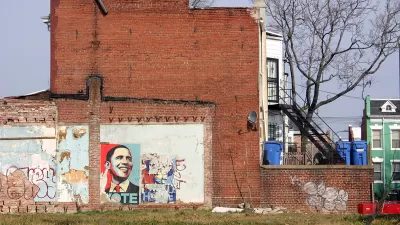A recent article refutes arguments used to defend gentrification, and in so doing identifies a culprit in glossing over the negative effects of displacement in areas both urban and suburban: hipster economics.

Sarah Kendzior begins a scathing critique of "hipster economics" by citing the example of a public art project in Philadelphia, funded by the National Endowment of the Arts and Amtrak, which blocks the views of train readers as they pass through impoverished neighborhoods in North Philadelphia. "Urban decay becomes a set piece to be remodeled or romanticised. This is hipster economics," writes Kendzior.
The article addresses directly many of the common arguments used to defend the effects of gentrification. "Proponents of gentrification will vouch for its benevolence by noting it 'cleaned up the neighbourhood'. This is often code for a literal white-washing. The problems that existed in the neighbourhood - poverty, lack of opportunity, struggling populations denied city services - did not go away. They were simply priced out to a new location."
Where poverty goes when its priced out of cities—namely, suburbs—makes it all the less likely to addressed in the future, says Kendzior. "There is no history to attract preservationists because there is nothing in poor suburbs viewed as worth preserving, including the futures of the people forced to live in them. This is blight without beauty, ruin without romance: payday loan stores, dollar stores, unassuming homes and unpaid bills. In the suburbs, poverty looks banal and is overlooked."
FULL STORY: The peril of hipster economics

Planetizen Federal Action Tracker
A weekly monitor of how Trump’s orders and actions are impacting planners and planning in America.

Map: Where Senate Republicans Want to Sell Your Public Lands
For public land advocates, the Senate Republicans’ proposal to sell millions of acres of public land in the West is “the biggest fight of their careers.”

Restaurant Patios Were a Pandemic Win — Why Were They so Hard to Keep?
Social distancing requirements and changes in travel patterns prompted cities to pilot new uses for street and sidewalk space. Then it got complicated.

Albuquerque Route 66 Motels Become Affordable Housing
A $4 million city fund is incentivizing developers to breathe new life into derelict midcentury motels.

DC Area County Eliminates Bus Fares
Montgomery County joins a growing trend of making transit free.

Platform Pilsner: Vancouver Transit Agency Releases... a Beer?
TransLink will receive a portion of every sale of the four-pack.
Urban Design for Planners 1: Software Tools
This six-course series explores essential urban design concepts using open source software and equips planners with the tools they need to participate fully in the urban design process.
Planning for Universal Design
Learn the tools for implementing Universal Design in planning regulations.
Heyer Gruel & Associates PA
JM Goldson LLC
Custer County Colorado
City of Camden Redevelopment Agency
City of Astoria
Transportation Research & Education Center (TREC) at Portland State University
Camden Redevelopment Agency
City of Claremont
Municipality of Princeton (NJ)





























